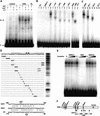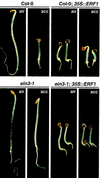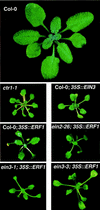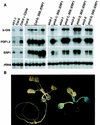Nuclear events in ethylene signaling: a transcriptional cascade mediated by ETHYLENE-INSENSITIVE3 and ETHYLENE-RESPONSE-FACTOR1
- PMID: 9851977
- PMCID: PMC317251
- DOI: 10.1101/gad.12.23.3703
Nuclear events in ethylene signaling: a transcriptional cascade mediated by ETHYLENE-INSENSITIVE3 and ETHYLENE-RESPONSE-FACTOR1
Abstract
Response to the gaseous plant hormone ethylene in Arabidopsis requires the EIN3/EIL family of nuclear proteins. The biochemical function(s) of EIN3/EIL proteins, however, has remained unknown. In this study, we show that EIN3 and EILs comprise a family of novel sequence-specific DNA-binding proteins that regulate gene expression by binding directly to a primary ethylene response element (PERE) related to the tomato E4-element. Moreover, we identified an immediate target of EIN3, ETHYLENE-RESPONSE-FACTOR1 (ERF1), which contains this element in its promoter. EIN3 is necessary and sufficient for ERF1 expression, and, like EIN3-overexpression in transgenic plants, constitutive expression of ERF1 results in the activation of a variety of ethylene response genes and phenotypes. Evidence is also provided that ERF1 acts downstream of EIN3 and all other components of the ethylene signaling pathway. The results demonstrate that the nuclear proteins EIN3 and ERF1 act sequentially in a cascade of transcriptional regulation initiated by ethylene gas.
Figures








Similar articles
-
Activation of the ethylene gas response pathway in Arabidopsis by the nuclear protein ETHYLENE-INSENSITIVE3 and related proteins.Cell. 1997 Jun 27;89(7):1133-44. doi: 10.1016/s0092-8674(00)80300-1. Cell. 1997. PMID: 9215635
-
Members of the tomato LeEIL (EIN3-like) gene family are functionally redundant and regulate ethylene responses throughout plant development.Plant J. 2001 Apr;26(1):47-58. doi: 10.1046/j.1365-313x.2001.01006.x. Plant J. 2001. PMID: 11359609
-
Ethylene-insensitive3 is a senescence-associated gene that accelerates age-dependent leaf senescence by directly repressing miR164 transcription in Arabidopsis.Plant Cell. 2013 Sep;25(9):3311-28. doi: 10.1105/tpc.113.113340. Epub 2013 Sep 24. Plant Cell. 2013. PMID: 24064769 Free PMC article.
-
Ethylene signaling in plants.J Biol Chem. 2020 May 29;295(22):7710-7725. doi: 10.1074/jbc.REV120.010854. Epub 2020 Apr 24. J Biol Chem. 2020. PMID: 32332098 Free PMC article. Review.
-
Ethylene gas: perception, signaling and response.Curr Opin Plant Biol. 1998 Oct;1(5):393-8. doi: 10.1016/s1369-5266(98)80262-8. Curr Opin Plant Biol. 1998. PMID: 10066624 Review.
Cited by
-
The Arabidopsis ETHYLENE RESPONSE FACTOR1 regulates abiotic stress-responsive gene expression by binding to different cis-acting elements in response to different stress signals.Plant Physiol. 2013 Jul;162(3):1566-82. doi: 10.1104/pp.113.221911. Epub 2013 May 29. Plant Physiol. 2013. PMID: 23719892 Free PMC article.
-
Deciphering the transcriptomic regulation of heat stress responses in Nothofagus pumilio.PLoS One. 2021 Mar 30;16(3):e0246615. doi: 10.1371/journal.pone.0246615. eCollection 2021. PLoS One. 2021. PMID: 33784314 Free PMC article.
-
Discovery of non-climacteric and suppressed climacteric bud sport mutations originating from a climacteric Japanese plum cultivar (Prunus salicina Lindl.).Front Plant Sci. 2015 May 12;6:316. doi: 10.3389/fpls.2015.00316. eCollection 2015. Front Plant Sci. 2015. PMID: 26029222 Free PMC article.
-
A Positive Feedback Loop Mediated by CsERF31 Initiates Female Cucumber Flower Development: ETHYLENE RESPONSE FACTOR31 mediates a positive feedback loop that initiates female cucumber flower development.Plant Physiol. 2021 Mar 21;186(2):1088-100. doi: 10.1093/plphys/kiab141. Online ahead of print. Plant Physiol. 2021. PMID: 33744968 Free PMC article.
-
Appearance and elaboration of the ethylene receptor family during land plant evolution.Plant Mol Biol. 2015 Mar;87(4-5):521-39. doi: 10.1007/s11103-015-0296-z. Epub 2015 Feb 15. Plant Mol Biol. 2015. PMID: 25682121
References
-
- Abeles F, Morgan P, Saltveit M. Ethylene in plant biology. San Diego, CA: Academic Press; 1992.
-
- Allada R, White NE, Venus So W, Hall JC, Rosbash M. A mutant Drosophila homolog of mammalian Clock disrupts circadian rhythms and transcription of period and timeless. Cell. 1998;93:791–804. - PubMed
-
- Baulcombe DC, Saunders GR, Bevan MW, Mayo MA, Harrison BD. Expression of biologically active viral satellite RNA from the nuclear genome of transformed plants. Nature. 1989;321:446–449.
-
- Bechtold N, Ellis J, Pelletier G. In Planta Agrobacterium mediated gene transfer by infiltration of adult Arabidopsis plants. CR Acad Sci Paris Life Sci. 1993;316:1194–1199.
Publication types
MeSH terms
Substances
Associated data
- Actions
- Actions
Grants and funding
LinkOut - more resources
Full Text Sources
Other Literature Sources
Molecular Biology Databases
